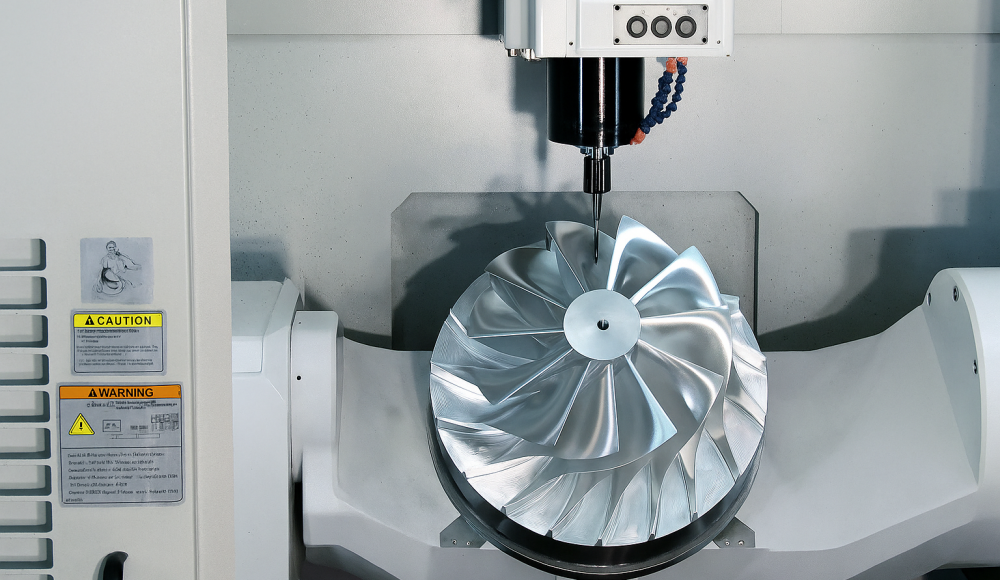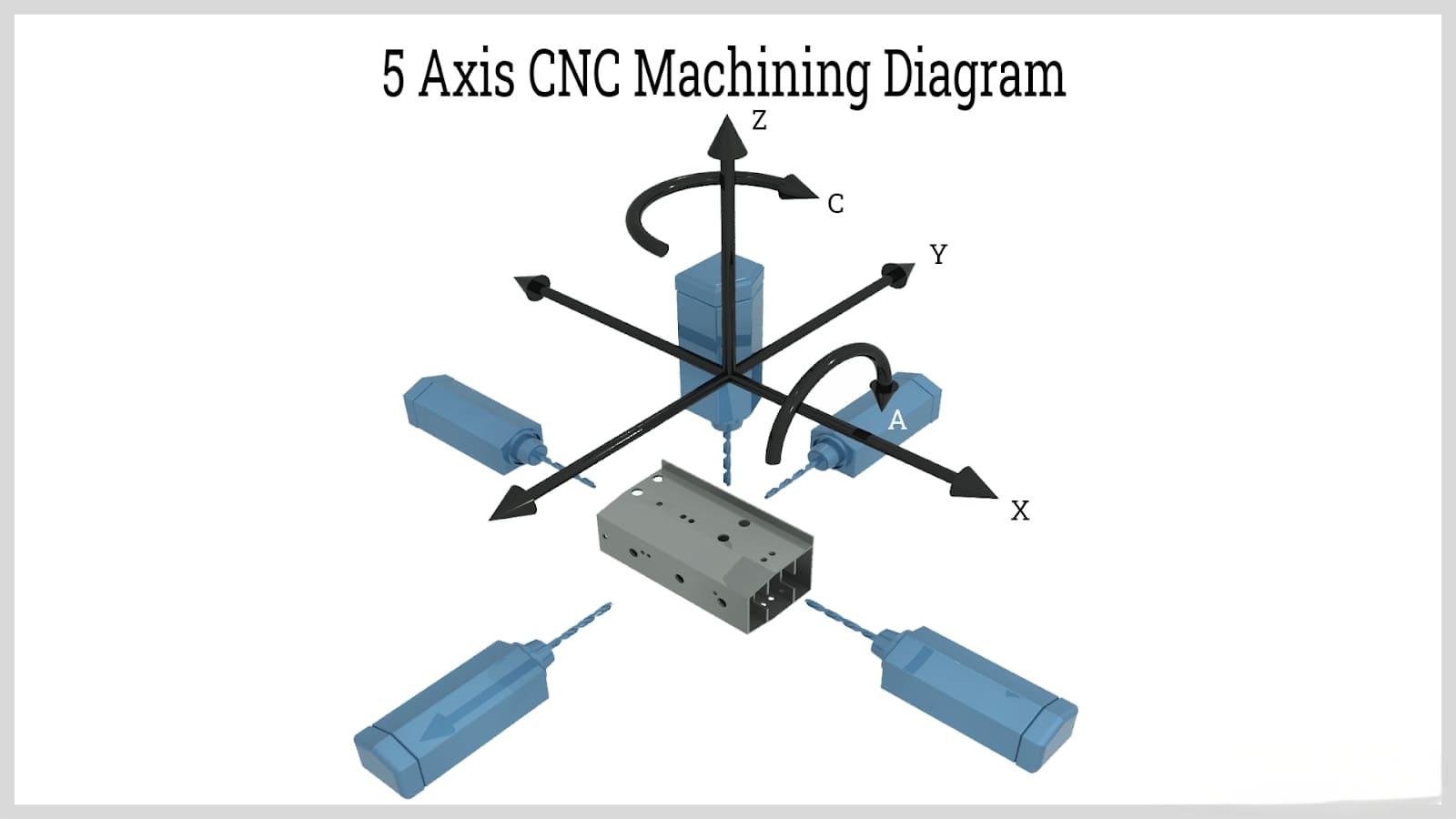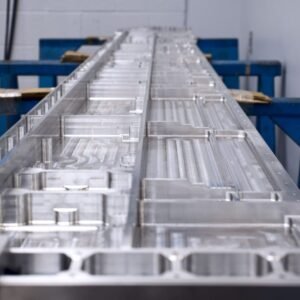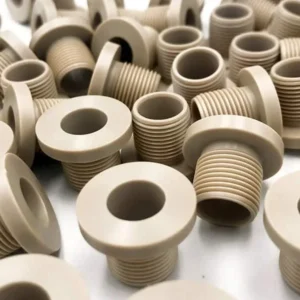През десетилетията, CNC обработка еволюира от прости триосни мелници в много сложни центрове с многооси. Днес, Истинската обработка на 5-осе представлява върха на изваждането на производството, Комбиниране на пет едновременни оси на движение за справяне с най -сложните геометрии в една настройка. Докато ранните впечатления от 5-осе центрове често включват „висока цена“ или „трудно програмиране,„Съвременните магазини показват, че с правилната инвестиция в софтуер, приспособяване, и обучение, 5-Обасната обработка изплаща дивиденти по точност, скорост, и свобода на дизайна.
Тази статия предоставя дълбоко гмуркане в 5-Обас на ос—Пролинг как работи, различните машини конфигурации, които ще срещнете, основните му предимства и недостатъци, и практически съвети за извличане максимално от тази мощна технология.
Какво е 5-осе обработка?
5-Обас на ос се отнася до операциите на ЦПУ, в които инструментът за рязане (или детайла) е в състояние да се движи едновременно в пет независими оси:
X-ос: наляво/надясно
Y-ос: отпред/отзад
Z-ос: нагоре/надолу
A-ос: въртене около оста x
B-ос: въртене около оста y
Чрез комбиниране на линейни движения (X, Y, З) с две ротации (А, Б), Истинската 5-осе машина може да се приближи до всяка повърхност на част от почти всяка ориентация, Елиминиране на необходимостта от разгръщане и повторно индексиране на детайла за различни лица.
Защо да използвате CNC за 5-осе обработка?
Сложност на едносетап
Достъп до пет различни лица - плот, отдолу, и всички страни - в една непрекъсната работа. Нито едно ръчно препозициониране не намалява времето за настройка и потенциала за грешки.
По -строги допустими отклонения
С по -малко настройки, Елиминирате кумулативните грешки от датчика до таблото. Повечето магазини постигат ± 0,005 мм (0.0002″) Повторяемост на центровете с 5 оси.
По -къси пътеки на инструмента
Инструментът може да се наклони и да се върти, за да поддържа оптимални ъгли на рязане, Намаляване на износването и вибрациите на инструмента.
По -бърз обрат
Сложните части, които веднъж се изискват специални тела или вторично смилане, вече могат да бъдат завършени с едно изпълнение, ускоряване на времето до пазара.
5-ОСС ОБЩО ОБЩО РАБОТА РАБОТА
CAD дизайн
Създайте напълно дефиниран 3D модел, Обръщайки специално внимание на критичните повърхности и подбивания, до които могат да достигнат само 5-ос.
CAM програмиране & Симулация
Импортиране на CAD модела в софтуера на CAM. Генерирайте пътеки с инструменти, използвайки 5-осе стратегии (напр., Swarf, накланящ джоб, Многостранно лице) и симулира, за да проверите за сблъсъци или изригки.
Генериране на G-код
След обработка на CAM инструменталните пътеки в специфичния за машината G-код, включително координирани движения на всичките пет оси.
Настройка на машината & Приспособяване
Закрепете детайла върху подходящо приспособление (нулева точка, надгробен камък, или обичай), и натоварване изисква инструменти за рязане в шпиндела.
Автоматизирана обработка
Изпълнете програмата под минимален надзор. Корекциите в движение могат да бъдат направени чрез сондиране или адаптивно управление.
Конфигурации на 5-осни машини
А. Глава/глава (Spinner Spinner)
Какво е: И двете допълнителни въртящи се оси са нагоре в главата на шпиндела - помислете за режещия инструмент, извършващ цялото завиване. Масата под ваша страна просто седи неподвижно.
Защо ще го изберете: Можете да се справите наистина големи, тежки детайли, защото масата не се движи наоколо. Чудесно за гигантски форми или дълги греди.
Часовници: Главата се накланя само досега, така че някои ъгли все още може да са недостъпни.
Б. Маса/глава (Обърнете „N“ наклона)
Какво е: Една въртяща ос е на масата (тя върти вашата част), И един е в главата (тя наклонява инструмента). Получавате много обхват, без да премествате цялата настройка.
Защо ще го изберете: Супер универсална - най -често срещана настройка. Можете да замахнете с частта си около почти 360 ° и все пак да наклоните инструмента за трудни ъгли.
Часовници: Въртящата се маса може да побере само толкова тегло, Така че има ограничение за размера на частта.
° С. Таблица/таблица (Въртене & Въртене)
Какво е: И двете допълнителни оси живеят на масата, Така че вашата детайла е единственото нещо, което се върти. Главата остава поставена, Преместване само нагоре/надолу и отстрани.
Защо ще го изберете: Перфектен за подбивания и супер тесни петна-вашата част може да се търкаля под инструмента от множество посоки.
Часовници: Обикновено се изгражда за по -малки, по -леки части. Получавате по -малко място за люлеене, И това не е най -бързата настройка.
Всеки стил има своето сладко място: Глава/глава за масивни парчета, Маса/глава за всестранна гъвкавост, и Таблица/таблица Когато трябва да се промъкнете във всяко кътче. Вашият избор се свежда до размера на частта, форма, И колко люлка и наклона наистина ви трябват.
Основни предимства на обработката на 5-осе
Комплексна геометрия
Машинно изваяни повърхности - турбини остриета, Комплекти, Анатомични импланти - без специални тела.
Прецизност & Повтаряемост
Едносетапът намалява грешките в препозициониране; постигайте допустими отклонения до ± 0,001 ″ последователно.
Намалено време за настройка
Пет лица в едно изпълнение на смяна на наклона и ръчно пренастройка.
Превъзходно покритие на повърхността
Кратките инструменти и оптималните ъгли на наклона минимизират отклонението на бърборенето и инструмента, Доставяне на RA < 0.4 µm завършва.
Висока пропускателна способност
Непрекъснато движение с пет оси, В комбинация с високоскоростни вретена, Драматично намалява времето за цикъл за сложни части.
Недостатъци и съображения
Капиталова инвестиция
5-Центровете на оси струват 2–3 × повече от еквивалентни 3-осни машини. Специализирани контролери и софтуер добавят към първоначалните разходи.
Сложност на програмиране
Мултиосовата кинематика изисква усъвършенствани стратегии за CAM и задълбочена проверка на сблъсъка.
Ниво на умения на оператора
Техниците трябва да разбират кинематиката на 5-оси, Разширено тегло, и проверка на съчетания - тренирането увеличава разходите за труд.
Идеални видове части за обработка на 5 оси
Свободна форма & Изваяни повърхности: Турбинни лопатки, медицински импланти, Автомобилни панели на тялото.
Диск & Части от чиния: БПЛА рамки, радиатори, Крайните капаци на двигателя с модели на радиални отвори.
Геометрии от тип кутия: Заграждения, скоростни кутии, колектори, изискващи много лице за достъп.
Специални неправилни форми: По-ниски скоби, контурирани форми, медицински изделия с органична форма.
5-Axis vs. 3+2-Обработка на оси
Вярно 5-ос = гладка, Непрекъснато движение
Инструментът (или таблица) Движи се на всичките пет оси в същото време, непрекъснато накланяне и въртене, докато се реже.
Резултат: Получавате наистина течни пътеки с инструменти, Супер гладки повърхности, и по -бързи цикли - без спиране и стартиране между разфасовки.
3+2-Ос = заключване, Накланяне, Нарязване
Мислете за това като за 3-осе мелница, която Паузи За да наклоните частта или да се насочите към нов ъгъл (Това са осите "+2"), След това заключва всичко и отрязва.
Резултат: Можете да достигнете до ъглови лица при по-малко настройки, отколкото прави 3-ос, Но всяка промяна на ъгъла означава спиране, препозициониране, и след това възобновяване-така че е по-бавен и по-малко безпроблемен от истинските 5-оси.
Кое трябва да изберете?
Отидете 5-оси Когато имате нужда от абсолютно най -бързо, Най-прецизни разфасовки на сложни криви и подбивания-идеални за аерокосмически или медицински части от висок клас.
Придържайте се с 3+2-ос Ако имате предимно призматична работа с случайни ъглови дупки или лица, И искате да спестите от разходите за машина и програмиране.
Стратегии за увеличаване на ефективността на 5-оси
Изберете правилния CAD/CAM апартамент
Потърсете вградено откриване на сблъсък, Разширена оптимизация на пътеката на инструмента (швейцарски стил, Обработка за почивка), и цифрови близнаци.
Инвестирайте в откриване на инструменти & Сондиране
Автоматизиране на компенсиране на дължината на инструмента и настройка на частта, за да намалите човешките грешки и смяната на скоростта.
Използвайте софтуер за симулация
Изпълнете пълни машини симулации, включително компоненти на закрепване, За да хванете сблъсъци и да оптимизирате времето на цикъла преди магазина.
Индустриални приложения
Космонавтика:
Какво правят: Турбинни лопатки, опори на двигателя, скоби за въздушна рамка.
Защо 5-оста помага: Тези криви, Извитите части на крилото се нуждаят от всеки ъгъл в една настройка. Няма втори шансове - плановете изискват перфектни пристъпи.
медицински & Зъболекар:
Какво правят: Тазобедрените импланти, Колянните стави, Персонализирани зъбни корони.
Защо 5-оста помага: Тялото на всеки пациент е уникално. 5-Оста ви позволява да издълбавате тези органични форми правилно първия път, Така че операциите вървят гладко.
електроника:
Какво правят: Топлоотводи, корпуси на камерата, Прецизни конектори.
Защо 5-оста помага: Малки функции и стегнати ъгли на дъски? 5-Axis Mills цип около тях, без да пропуска ритъм.
енергия & Масло & Газ:
Какво правят: Помпата на помпата, тела на клапаните, свредла нашийници.
Защо 5-оста помага: Части в този свят виждат луди налягания и потоци. 5-Оста осигурява гладка, балансирани повърхности, които продължават.
Автомобилна & Състезания:
Какво правят: Турбокомпресор колела, компоненти на окачването, Персонализирани колектори.
Защо 5-оста помага: Високопроизводителните двигатели се нуждаят от перфектни пътеки и светлина на въздушния поток, Силни части-5-оси нокти и двете.
Инструмент & Създаване на умиране:
Какво правят: Форми за пластмасови части, щамповане умира, Коване на блокове.
Защо 5-оста помага: Сложни кухини и подбивания в едно парче? 5-Оста може да се справи, без да се счупи пот.
Архитектура & Чл:
Какво правят: Изваяни фасади, Метално изкуство по поръчка, сложни панели.
Защо 5-оста помага: Голям, фантастични форми с художествен усет? 5-Axis превръща цифровите дизайни в реални фактори на WoW.
Заключение
5-Охранителната обработка стои като трансформативна технология за производство на силно сложни, Части за толерантност при по-малко настройки и с превъзходни облицовки. Докато авансовите разходи и техническите изисквания са по-високи, отколкото за центровете с 3 оси, несравнимите възможности-и спестяването на време и труд-правят 5-осен обработване на крайъгълен камък за напреднало производство.
Чрез внимателно избор на правилната конфигурация на машината, инвестиране в софтуер и обучение, и прилагане на най -добрите практики (сондиране, симулация, Откриване на инструменти), Производителите могат да отключат пълния потенциал на 5-осен CNC, за да доставят по-бързо, по -точно, и рентабилни решения в широк спектър от индустрии.
Често задавани въпроси
Q1: Какъв език за програмиране използват 5-осни CNC машини?
Те използват G-код, разширен с многоосни команди (напр., А, B Оста се движи) Генерирано от CAM пост-процесори.
Q2: Кои материали могат да бъдат обработени в 5-осни центрове?
Почти всеки - алуминиев, титан, неръждаема стомана, Инженерна пластмаса (PEEK, Найлон), композити, и още.
Q3: Как да избера между главата/главата, Маса/глава, и конфигурации на таблица/таблица?
Основа на вашия избор на размера на частта, сложност на приспособяване, и изисква ротационно пътуване:
Много големи части → Глава/глава
Универсална работа със среден размер → Маса/глава
Подрязвания & сложни малки части → Таблица/таблица
Прочетете повече:
5 Сервиз за CNC обработка на Axis
Приспособления и приспособления: Всичко, което трябва да знаете
CNC прототипна обработка: Всичко, което трябва да знаете




